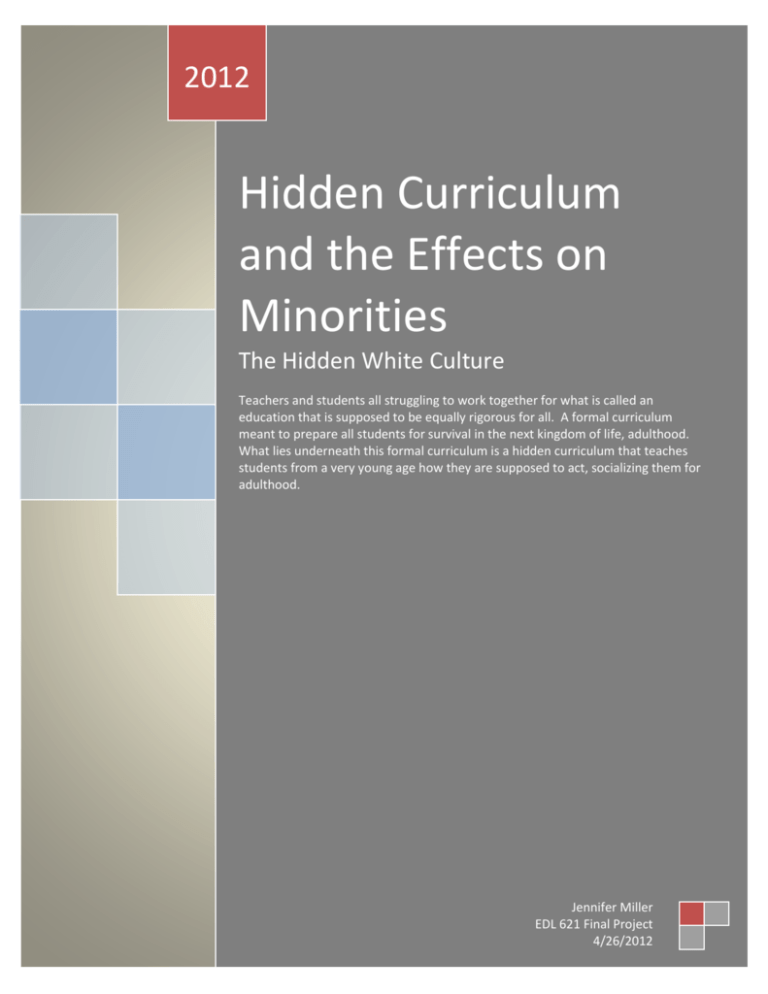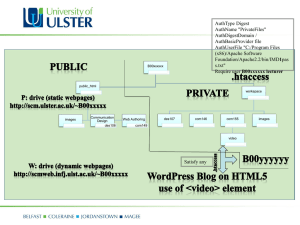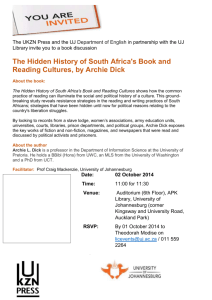Hidden Curriculum and the Effects on Minorities
advertisement

2012 Hidden Curriculum and the Effects on Minorities The Hidden White Culture Teachers and students all struggling to work together for what is called an education that is supposed to be equally rigorous for all. A formal curriculum meant to prepare all students for survival in the next kingdom of life, adulthood. What lies underneath this formal curriculum is a hidden curriculum that teaches students from a very young age how they are supposed to act, socializing them for adulthood. Jennifer Miller EDL 621 Final Project 4/26/2012 The bell rings and hallways are quickly filled with bodies. It’s a Darwin like atmosphere of predators and prey. There are guys that are too masculine or not masculine enough and girls that are feminine or maybe not feminine enough. It’s a constant struggle of what to wear, how to dress, and more so how to act to survive in this jungle like atmosphere. It is a cruel world for teenagers in what we call high school. Teachers and students all struggling to work together for what is called an education that is supposed to be equally rigorous for all. A formal curriculum meant to prepare all students for survival in the next kingdom of life, adulthood. What lies underneath this formal curriculum is a hidden curriculum that teaches students from a very young age how they are supposed to act, socializing them for adulthood. Hidden curriculum is not supposed to be there, it’s not a part of the intended agenda. However, it plays a very important part in the grooming of teenagers for the adult lives. Unfortunately, for minorities the hidden curriculum is not as beneficial for them as their white peers. Hidden curriculum is unintended, implicit, invisible, unwritten, covert, latent, silent, and what schooling does to people. Schools subtly socialize students to respect culture and become functioning members of society. For example, look high school mission statements; they always include something like preparation for responsible living, or something to that nature. Historically the United States has been racist, sexist, and a very discriminatory culture. So we can examine history and determine it is that of white culture that is passed down by 1|Page predominately white teachers. Emile Durkheim observed that education was, “methodical socialization of young generation.”(Durkheim, 51) Hidden curriculum is the subtle influences and unintended outcomes from education. It is the many things which are taught in school besides the mandated subject matter, for example, students learning how to behave in class, rules of conduct, classroom organization, being polite, or becoming popular or not. What schools do not teach may be as important as what they do teach. Ignorance is not simply a neutral void. It has an important effect on the kinds of options one is able to consider, the alternatives one can examine, and the perspectives from which one can view a situation or problem. If one of the purposes of schooling is to foster wisdom, weaken prejudice, and develop the ability to use a wide range of modes of thought, then we ought to look carefully at what the schools do not include in the curriculum. Curriculum reflects the realities of power and influence within our culture. Curriculum selection is a cultural and political act—whether or not one is conscious of it. The language teachers’ use, the curricula they employ, the values they hold can be described as cultural capital. Education distributes and legitimates certain forms of: knowledge, language practices, values, and ways of talking, acting, moving, dressing, and socializing. Schools are not merely instructional sites; they are sites where culture of dominant society is institutionalized. According to the United States Department of Education When the government last counted during the 1999-2000 school year, about 84% of teachers were white vs. 61% of 2|Page students. 90% 80% 70% 60% White 50% Hispanic 40% Black 30% Others 20% 10% 0% Students Teachers Black pupils make up about 17% of public school students, while fewer than 8% of teachers are black. Hispanics have risen to about 16% of all students, but fewer than 6% of teachers are Hispanic. During the 1999-2000 school year, 38% of public schools had not a single teacher of Public Schools With Minority Teachers Without Any Minority Teachers color. 3|Page . Of course I do expect that these numbers have changed, but I am not so sure it is the demographics of the teachers that changes but more so the populations of minority students. In a diverse society such as the U.S. where different values, traditions, and worldviews separate the students from the teachers, conflict is inevitable. The resistance theory in education is occurring because students are rejecting the traditional curriculum not because they are not smart enough to succeed in the work, but because they see this education as not representing their family or cultural values. For many disadvantaged students, success in school means a type of forced cultural suicide. “It is well known that research on the correlates of students' track placement has routinely revealed important associations between placement and students' socioeconomic status and race-ethnicity.” (Lucas, 328) “Analysts contend that pronounced tracking systems maintain racial, ethnic, and social-class segregation and thus that de facto tracking is driven, in part, by the sociodemographic composition of schools.” (Lucas, 328) These findings and suggestions are to me another huge part in the inconsistencies found in our educational system. How can minorities begin to move forward if they are pushed into lower level classes and taught nothing that equates to their white peers? Without teachers who can relate to their culture and rigorous classes minorities will continue to spiral downward in our society. “The racial separation we see in schools might be also be seen as an element of the “hidden curriculum,” an unspoken set of rules that “teaches” certain students what they can and cannot do because of who they are. There are aspects of this hidden curriculum that 4|Page are not being taught by the adults. It may well be that students are the ones teaching it to each other.” (Lucas, 340) Our society and future generations cannot begin to move forward past our racial discrimination until we are pushed to deal with them head on and place human integrity in front of what we believe will turn a profit. Education is instrumental in achieving that goal. We as a nation must embrace our cultural differences and learn from them, move past our fear of the unknown and enhance our own individual lives with knowledge. “As they start to realize that in this society to be Black or Brown means to be seen as “less than” -- whether it be less smart, less capable, or less attractive -- they will often express a desire to be associated with the dominant and more powerful group.”(Lucas, 330) My heart is saddened by the inconsistencies in our educational system. I find that more often than we would like to admit we fail a great number of our racial and ethnic minorities in our educational system. Without acknowledging these downfalls and making drastic changes to propel these students in a different direction we are allowing them, for the most part, to dwell and fester in their existence of poverty with no way out. I feel that in order to address the problems that lie in the hidden curriculum we need to address the whole staff, administration, and teachers and ensure that we are building a faculty that matches the demographics of the school. Also, beyond that we need to ensure that the majority of staff, Caucasians, is trained in diversity relations so we can begin to take steps to ensure the overcoming of a long time standing white curriculum and white culture in high schools. 5|Page In order for change to occur schools need to recruit, hire, and retain teachers, administrators, and staff of color by developing new partnerships with colleges and universities that are historically noted as Hispanic or Black populated to recruit undergraduate and graduate students for hire. Look at hiring practices and ensure that all levels of staff are trained in diversity relations and implement diversity and equity questions in the interviewing process. Develop relationships with local diverse community organizations such as: Urban League, NAACP, and the Hispanic Chamber of Commerce. By doing these things it will ensure that the staff, teachers, and administrators reflect the composition of the students. Furthermore, they need to increase and improve cultural competency of all teachers, administrators, and staff by provide cultural competency training for all staff, administrators, and teachers, including new hires. Develop a cultural liaison team for each school and have them on-site. Develop a multicultural awareness brochure available in many different languages. Create a library of non-fiction literature and on-line tools for teachers to use to implement in cultural competency. By doing these things it will ensure that cultural competency is increased on all levels at the school sites. By promoting healthy and informed cultural diversity it will further enhance relationships between people in the school enhancing their relationships and increasing achievement standards and scores. Also, schools need to improve community communication regarding diversity initiatives. The first change in this case needs to be in the school’s climate to ensure that families with different primary languages feel welcomed into the schools. You can start by making all initial school registration paperwork jargon free and available in different languages. The registration 6|Page office needs to be welcoming as well with signs in different languages, pictures promoting happy families of many different nationalities. By gaining their confidence at this point we later will have their attention to utilize further resources that will be available for them. Also, changing the school websites to make them more welcoming to non-English speaking families, creating multicultural handbooks in multiple languages that highlights all community resources and tools available to families, and by highlighting cultural families, students, and/or traditions in the monthly newsletter and make it available in different languages. Continue change by developing student engagement and learning opportunities regarding diversity. Create a STEM program from elementary through high school that will increase the number of diverse students in those classes and eventually careers. Increase the number of diverse students in AP classes. Increase student and teacher relations, a teacher should have the highest expectations for their students and by increasing relationships hopefully it increases the desire to propel forward. Overall, in a country where we have adopted this notion of “No Child Left Behind” and accepted a creed that we shall afford every child regardless of their nationality, race, religion, or socio-economic background the same rigorous education, we are failing intolerably. While our education system works for some, for our minorities we are for the most part failing them miserably. It is obvious that we need to reach out to all students to better prepare them for careers in our technology based world but more so, we need to focus on providing an equal education for our minority students that allows them to excel in life with equal opportunity. More so, a life that does not propel them into poverty and crime. 7|Page References: Emile Durkheim, Education et sociologie, p. 51, Paris, Presses Universitaites de France, 1992. Fordham, Signithia. and Ogbu, John U. (1986). Black students' school success: Coping with the "burden of acting white." Urban Review 18: 176-206. Lucas, S. R., & Berends, M. (2002). Sociodemographic Diversity, Correlated Achievement, and De Facto Tracking. Sociology Of Education, 75(4), 328-348. U.S. Department of Education, www.ed.gov. 8|Page



